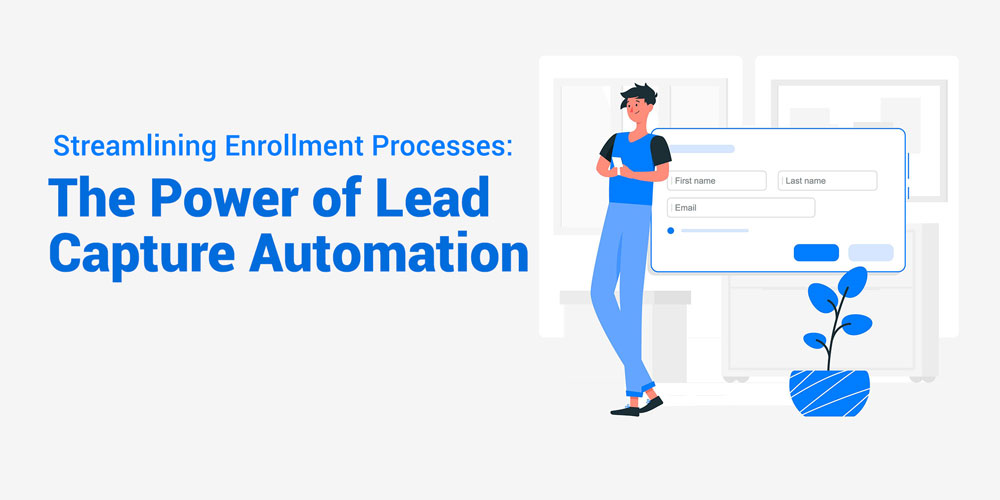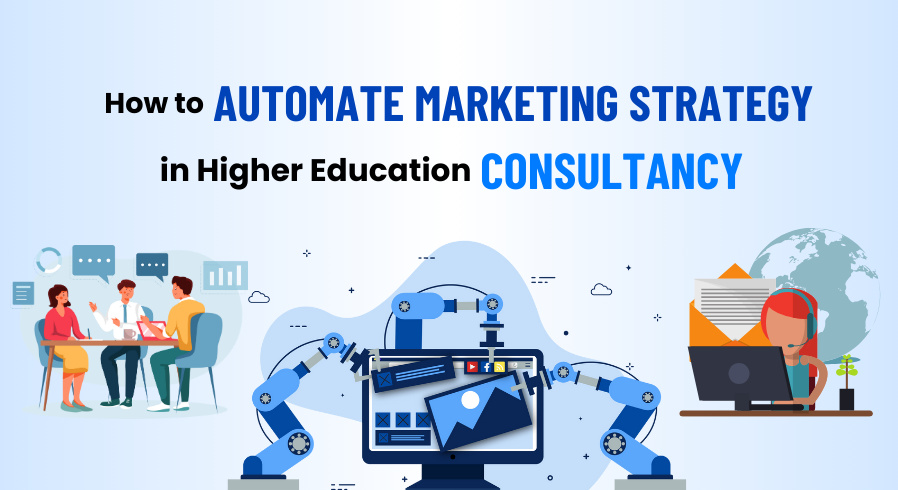Table of Contents

In today's fast-paced educational landscape, institutions are constantly seeking ways to optimize their enrollment processes. One transformative solution gaining traction is lead capture automation, a powerful tool designed to revolutionize how educational institutions engage with prospective students. By harnessing advanced technology, this automation streamlines the intricate dance of capturing leads, freeing up resources and time for more strategic endeavors.
Lead capture automation brings together various components such as CRM systems, AI-driven chatbots, and predictive analytics, all working in harmony to enhance enrollment efficiency. With reduced response times and increased engagement, educational institutions can foster a more dynamic and responsive admissions process. This not only benefits the administrative side but drastically improves the experience for students, making their journey from interest to enrollment seamless and personalized.
In this article, we delve into the intricate world of lead capture automation, exploring its key components, benefits, and implementation strategies. We'll examine how real-time data utilization and collaborative efforts between marketing and enrollment teams lead to greater success. Additionally, the nuances of overcoming challenges, like data privacy concerns, will be addressed, providing a comprehensive guide to leveraging automation for enrollment excellence.
Understanding Lead Capture Automation
Lead capture automation is a powerful tool for modern educational institutions. It automates collecting and managing student leads with software. This process targets streamlining lead generation and improving enrollment rates. By using web forms, landing pages, and email campaigns, lead capture funnels prospective student data directly into a customer relationship management (CRM) system. This helps institutions smooth their enrollment journey. Automating these repetitive tasks lets admissions teams focus more on personalized communications and data-driven decisions, ultimately enhancing student experiences and satisfaction.
Definition and Purpose
Lead capture automation refers to using software tools to collect and manage leads. These tools often include web forms, landing pages, and email campaigns. The main goal is to make the lead generation process more efficient. In education, managing high volumes of prospective students can be challenging. Automation helps admissions teams engage potential students effectively. By reducing human errors and increasing conversion rates, these tools improve enrollment processes. Marketing automation platforms use features like contact forms and lead magnets to personalize the student experience. This helps educational institutions enhance their relationships with students.
Key Components of Lead Capture Automation
Lead capture automation uses software to streamline processes. This involves capturing potential student data through various online channels, such as web forms and landing pages. These tools connect with CRM systems, which reduces manual data entry and errors. Automating this process saves time for admissions teams, allowing them to focus on timely communication with prospective students.
Marketing automation is crucial for educational institutions. It uses lead magnets and automated submission forms to attract potential students. These elements ensure that information is collected efficiently and accurately. As a result, institutions can make data-driven decisions to improve their marketing campaigns. This leads to better conversion rates and ultimately higher enrollment rates. By refining how student inquiries are handled, these automation tools boost overall student satisfaction.
Benefits of Lead Capture Automation in Enrollment
Lead capture automation is transforming how educational institutions handle student enrollment. By automating the process, institutions reduce manual tasks and minimize errors. This leads to a more seamless enrollment experience for prospective students. Automation tools gather and manage student inquiries without the need for constant human intervention. This not only saves time but also allows the admissions team to focus on more critical tasks. Automation can enhance the relationship between students and institutions. By doing so, it improves both conversion and enrollment rates. From data integration to streamlined communications, institutions are finding new ways to enhance operations through automation.
Increased Efficiency
Efficiency is a major benefit of lead capture automation. By automating repetitive tasks, educational institutions save time and resources. Marketing automation helps schools personalize communication, ensuring timely outreach to prospective students. Automated lead systems also reduce paperwork, leading to improved operational efficiency. This approach allows educational institutions to handle large volumes of student inquiries effortlessly. Lead capture software consolidates data from various sources, improving data management. With fewer human errors, the chances of achieving higher enrollment rates increase. Overall, automation helps educational institutions run smoother by eliminating many of the cumbersome tasks involved in student enrollment.
Enhanced Prospective Student Engagement
Engaging prospective students is crucial for successful enrollment. Automation tools make this engagement more effective by using data analytics. Schools/Universities can customize communication strategies based on student preferences. Automated systems can predict what each student might be interested in and tailor messages accordingly. Multi-channel communication tools reach students through emails, SMS, whatsapp, and social media, offering immediate contact. This personalized approach helps maintain student interest. Marketing automation also assists in building stronger relationships by automating frequent tasks and personalizing interactions. This level of personal engagement is key to fostering long-lasting connections between students and their future schools.
Reduction in Response Time
Reducing response time in the admissions process is possible through automation. A quick response is crucial, with many students expecting replies within an hour. Automated communication systems, such as chatbots, make 24/7 availability achievable. Intelligent call routing directs inquiries to the right admissions counselors promptly. This ensures prospective students receive timely help. Enrollment automation setups streamline the overall workflow, eliminating repetitive tasks. As a result, schools can notify interested students faster. This timely communication improves student satisfaction and encourages enrollment.
Technology Behind Lead Capture Automation
Lead capture automation in student enrollment uses various digital tools like web forms, landing pages, email campaigns and whatsapp campaigns. These tools work together to gather and manage leads more efficiently. This approach helps educational institutions streamline the enrollment process by reducing manual tasks and enhancing sales efforts. With marketing automation software, lead capture often includes features like lead magnets. These are incentives designed to entice prospective students to share their contact information and begin their enrollment journey. Workflow tools, when paired with AI, ensure that institutions can communicate instantly and personally with potential students. This approach is tailored to each student's unique needs, making the process smoother and more effective. CRM systems also integrate with marketing channels to organize prospect data. This allows for segmented and personalized outreach, which is vital for maintaining relationships with students.
Advanced CRM Systems
Advanced CRM systems play a key role in education by enhancing prospect data capture and simplifying interaction tracking. They provide institutions with a detailed view of a student's journey by using advanced technology-driven data collection methods. This holistic view ensures that every touchpoint with a prospective student is tracked and analyzed. Often, CRM systems incorporate AI-driven predictive analytics tools. These tools help forecast potential enrollment trends and fine-tune strategies to increase effectiveness. To maximize the benefits of a CRM system, comprehensive training is essential. This ensures that the admissions team fully adopts the software and runs a seamless enrollment process. Furthermore, integrating CRM systems with other tools, like student information systems, is crucial. This connection fully automates and enhances the enrollment processes, making them more efficient and less prone to human errors.
AI-Driven Chatbots
AI-driven chatbots are revolutionizing how educational institutions manage student inquiries. These chatbots send reminders to admitted students about critical next steps. This helps increase enrollment rates and reduces the risk of losing students over the summer, known as summer melt. Capable of handling a variety of student inquiries, chatbots ensure personalized interactions without overburdening staff, maintaining high levels of engagement. By integrating AI chatbots, schools can automate lead capturing and quickly resolve queries. This minimizes the demand for human intervention in repetitive tasks. Additionally, AI chatbots improve conversion rates by offering valuable information to potential students. This is especially useful for those who may leave a course page without completing a form. Overall, AI-driven chatbots enhance the efficiency and effectiveness of lead management and the admissions workflow by automating routine communications and data collection.
Predictive Analytics
Predictive analytics in education marketing provides significant insights into potential enrollment outcomes. By evolving into prescriptive analytics, AI not only forecasts these outcomes but also suggests strategies tailored to different student segments. Predictive analytics enables institutions to track social media sentiment. This helps create marketing campaigns responsive to new trends and interests detected by AI. When combined with marketing automation, predictive analytics improves targeting. It identifies successful recruitment channels through detailed analysis of enrollment data. This provides real-time insights into lead generation, engagement, and conversion rates. Institutions can then make informed, data-driven decisions to fine-tune their marketing strategies. Furthermore, predictive analytics helps optimize the enrollment funnel by identifying and addressing potential bottlenecks. This strategic approach aims to boost conversion rates, making the overall enrollment process more effective and efficient.
Implementing Automated Workflows
Automated workflows offer significant benefits in the enrollment processes of educational institutions. They enhance efficiency by capturing student information and streamlining communication. This allows staff to focus more on building relationships with students. Automation in these workflows also reduces repetitive tasks, which minimizes human errors and delays in the enrollment process. By integrating automated document processing, institutions can ensure timely communication and real-time updates with potential students and parents. Moreover, these systems can facilitate secure financial transactions, covering every aspect of the enrollment journey. With the implementation of automated workflows, students and staff experience a more seamless and satisfying enrollment process.
Document Processing
Document processing, when automated, plays a crucial role in improving the efficiency of educational institutions. Manual enrollment processes are often burdened with errors and time-consuming tasks. Automation tackles these issues, reducing the time and resources associated with enrollment procedures. By transforming data entry into seamless workflows, institutions can easily notify stakeholders and send essential communications. This not only enhances overall efficiency but also frees up administrative teams to invest in building stronger student relationships. Ultimately, automated document processing leads to a streamlined process that benefits both staff and students alike.
Fee Collection
Fee collection, a critical yet cumbersome aspect of enrollment, can be greatly simplified through automation. Automated payment systems enable institutions to streamline fee collection while reducing the likelihood of errors. These systems provide real-time visibility into financial transactions, ensuring a seamless and secure payment experience for students. Integrating CRM platforms allows for automated fee reminders and multi-channel payment acceptance. By embracing such technology, educational institutions not only improve efficiency but also enhance student satisfaction throughout the financial transactions involved in enrollment.
Dynamic Communication Channels
Dynamic communication channels are essential in engaging prospective students effectively. Educational institutions utilize these channels for hyper-personalized and timely communication that resonates with student needs. By using CRM systems, institutions can send targeted messages, such as financial aid details, based on student interactions. Multi-channel communication tools—including email, whatsapp, SMS, and chatbots—facilitate this outreach. Automation further streamlines these processes, improving organizational efficiency through tasks like lead follow-up and reminders. By adopting personalized communication strategies driven by data analytics, institutions can significantly enhance their relationships with students, enriching their overall experience.
Data Utilization for Enrollment Success
Data analytics is becoming key in transforming the enrollment process. In particular, enrollment automation software helps educational institutions by providing real-time insights. These insights are about lead generation and student engagement, among other metrics. By leveraging data, schools can make informed decisions to enhance their recruitment strategies. This includes identifying where the enrollment process slows down and adjusting marketing plans accordingly. Integration of CRM and marketing automation makes these insights more accessible. This allows schools to tailor their efforts based on real-time data. Furthermore, by optimizing resources, educational institutions ensure a better experience for potential students. Thus, data utilization is not just about collecting information but using it effectively to drive the success of enrollment campaigns.
Real-Time Reporting
Automation has made real-time reporting in student enrollment a reality. Educational Institutions can now track enrollment status as it happens. This immediate oversight allows for quick identification and resolution of problems in the enrollment funnel. Marketing automation systems offer user-friendly interfaces. These interfaces display essential metrics, such as top-performing emails and website interactions. Schools can customize these reports to suit their needs. For example, they might look at performance by location or specific programs. With these comprehensive tools, educational institutions can readily track and refine their marketing campaigns. This capability ensures they achieve their enrollment goals while managing growth effectively.
Data-Driven Decision Making
Enrollment automation tools provide advanced analytics to help institutions with decision-making. By analyzing data on lead generation and conversion rates, schools can pinpoint where improvements are needed. This allows them to enhance their marketing strategies efficiently. Focusing on successful recruiting channels becomes easier with detailed insights. Additionally, data-driven decision-making helps evaluate student interactions and the success of marketing campaigns. Tools such as enrollment software provide real-time insights to enhance institutional conversion rates. By combining marketing automation with CRM solutions, schools can strategically make informed decisions. This optimizes enrollment outcomes by relying on concrete, data-driven insights.
Predictive Marketing Tactics
Predictive marketing is changing the landscape of enrollment strategies. It moves beyond simple predictions to suggesting concrete actions for different student groups. With marketing automation, educational institutions can use social media sentiment analysis. This helps detect trends in academic interests and adjust their campaigns accordingly. Additionally, integrating voice technology presents new avenues. For example, potential students can interact with university systems through smart speakers to acquire information. Automated email marketing can craft series of emails leading up to important events. By staying engaged, institutions keep prospective students interested. The integration of marketing automation and CRM systems enhances these tactics. This provides valuable insights that guide schools in optimizing their enrollment strategies.
Enhancing Student Experience
In today's digital age, online enrollment systems and data analytics have reshaped how students enroll in educational institutions. These tools provide valuable insights and streamline the enrollment process. By integrating centralized databases through Customer Relationship Management (CRM) platforms, institutions ensure that records are both accurate and secure. This organized approach enhances reliability for prospective students. Moreover, marketing automation tools facilitate lead nurturing and personalized communications. As a result, potential students receive targeted messaging that guides them through their enrollment journey efficiently. Automation reduces repetitive tasks and human errors, leading to a smoother, more effective experience for students. Ultimately, these technologies foster better relationships with students and contribute to higher satisfaction rates.
Personalized Outreach
Personalized outreach is vital in today's competitive education market. Marketing automation platforms empower educational institutions to craft tailored communication strategies. Tools like ActiveCampaign allow for the creation of detailed workflows that greatly enhance lead nurturing efforts. By sending targeted, relevant content, institutions keep both students and their parents informed. This engagement helps boost enrollment rates and ensures that prospective students are less likely to drop off during the journey. Using multiple channels such as email and SMS, schools maintain timely communication, increasing the odds of successful conversions. Moreover, CRM systems integrated with Student Information Systems (SIS) can flag specific interests, like financial aid. This capability enables automatic distribution of necessary materials, such as scholarship packets, making the outreach more impactful.
Tailored Marketing Efforts
Tailored marketing efforts rely on advanced technology to connect with today’s tech-savvy students. By integrating CRM systems with marketing automation, educational institutions enhance lead generation and segmentation. Hyper-personalized marketing engages both students and parents through precise communication. By using customizable tools—such as custom fields and pick lists—universities can create logical landing pages that resonate with their audience. Automation simplifies delivering event-specific content, like success stories, which heighten the impact of event promotions. Additionally, multi-channel marketing strategies ensure educational campaigns reach target audiences effectively across social media, mobile, web, and offline channels. This strategy not only nurtures relationships with current students but also with alumni, making the marketing efforts more comprehensive and successful.
Resource Allocation
Resource allocation is essential for implementing effective marketing and enrollment strategies. Although this section contains limited data, it's clear that allocating resources wisely affects the enrollment process greatly. Educational institutions need to assess where their marketing efforts have the most impact. Investments in CRM systems and marketing automation platforms ensure that admissions teams work efficiently and engage with potential students in meaningful ways. By focusing on creating data-driven decisions, schools can optimize marketing campaigns and improve response times. Ultimately, smart resource allocation allows institutions to improve conversion rates and boost overall enrollment figures, enhancing the student inquiry process and experience.
Collaboration Between Marketing and Enrollment Teams
Successful collaboration between marketing and enrollment teams in educational institutions is vital. With CRM tools managing leads and tracking interactions becomes more efficient. This helps teams work together smoothly. Marketing automation facilitates seamless communication and coordination among admissions teams, which improves team alignment. Robust lead management and analytics capabilities also play a role. They support the optimization of marketing and enrollment strategies. This ensures that decisions are data-driven and strategies are effective. When both teams use insights wisely, they enhance student recruitment efforts. Overall, collaboration becomes more harmonious and productive.
Reducing Administrative Overhead
Lead capture automation is a game-changer. It significantly cuts down on administrative tasks by automating how leads are collected and managed. This saves time and reduces errors. Implementing an Education CRM centralizes activities like application processing and document verification. This streamlines workflows and eases manual burdens. By aligning automated workflows with institutional processes, response delays are minimized. This reduces lead leakages and boosts team productivity. Additionally, automation in marketing processes, such as AI chatbots and email campaigns, manages large volumes of leads without manual intervention. Customized automated submission forms further assist in gathering prospective student inquiries efficiently. This all leads to fewer administrative tasks and more streamlined processes.
Streamlining Follow-Ups
Following up is crucial in the enrollment process, and automation makes it easier. Automated emails and notifications are triggered by each applicant's progress. This ensures timely communication without the need for constant oversight. Automation helps maintain consistent engagement and reduces missed opportunities. It can even include reminders for documents like transcripts. Enrollment automation notifies staff when high-priority applications are received, allowing personalized engagement. Such systems can organize steps and set tasks for school/college/University staff, ensuring that follow-ups are thorough. With enhanced transparency, institutions using automation have seen a significant rise in engagement and applicant trust.
Improving Conversion Rates
Lead capture automation has a notable impact on increasing conversion rates. By enabling quicker follow-ups and personalized communications, prospective students receive timely and relevant interactions. This results in a smoother enrollment process. Automated workflows save over 10 hours weekly, making recruitment efforts more efficient. Automated, targeted communications such as personalized emails, whatsapp message and chatbots keep prospective students engaged. This enhances the transition from inquiry to enrollment. Additionally, prioritizing high-scoring leads through automated lead scoring systems further boosts conversion rates. With this approach, institutions have seen improved recruitment results, yielding substantial returns on investment. Ultimately, lead capture automation elevates the entire enrollment journey.
Challenges and Considerations
Educational institutions face many challenges when managing large volumes of leads. Tailoring personalized marketing messages for prospective students is often a complex task. Automation can help, but it must be user-friendly. This ease of use helps to prevent confusion among students and parents. Another consideration is security. Automated systems need robust measures like encryption and access controls to protect sensitive student data. Additionally, automation may spark concerns about job security for current enrollment staff. This may lead to retraining or changes in roles. To choose the right tools, institutions must assess their needs and consider the financial implications of automation. This includes both initial costs and long-term benefits.
Data Privacy Concerns
Data privacy is a significant concern with automated systems. These systems gather a lot of personal information, often through web forms and landing pages. For educational institutions using CRM-integrated marketing tools, data security is key. Protecting sensitive information should always be a priority. It's crucial to comply with data protection regulations when using automated submission forms. These measures help safeguard the personal data of potential students and clients. Additionally, analyzing large sets of enrollment data needs strict governance. This ensures the privacy and security of sensitive information throughout the process. Automated follow-up sequences via SMS and digital platforms also require robust privacy measures. These steps protect personal communication details, maintaining trust with both prospective and current students.




_1750243890.jpg)




